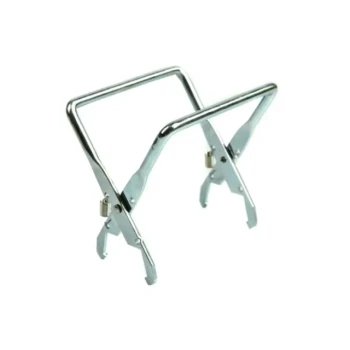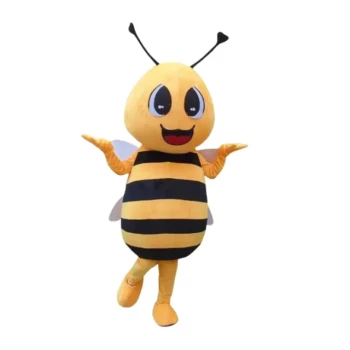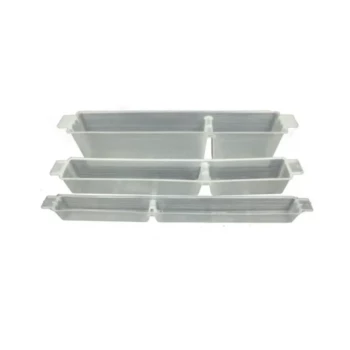At its core, a beekeeping veil is a protective mesh head covering. Its primary purpose is to shield your face, head, neck, and ears from bee stings while you inspect and work with your hives. Because bees often target the face when they feel threatened, the veil is arguably the most critical piece of protective equipment for any beekeeper.
A beekeeping veil is not just about preventing pain; it's a tool that enables focus. By removing the fear of stings to the face, it allows you to remain calm and deliberate, which is safer for you and less stressful for the bees.
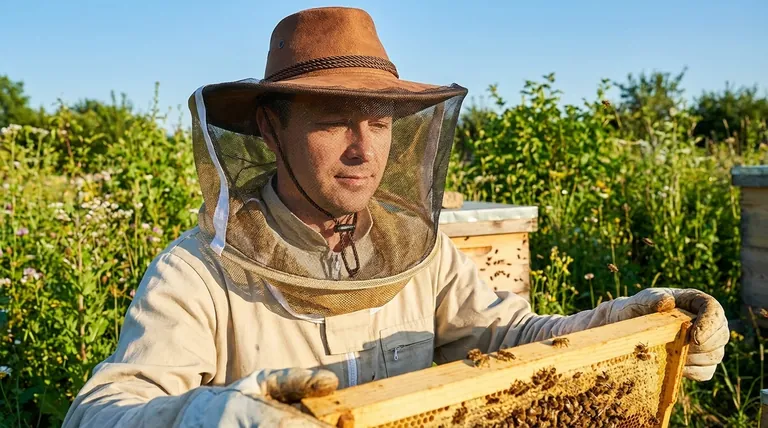
Why Facial Protection is Non-Negotiable
A common question from new beekeepers is whether a veil is truly necessary. The answer is an unequivocal yes. Understanding the reasons reveals its importance in modern beekeeping.
Bees Target the Head and Face
When bees perceive a threat, their defensive response is often directed towards dark, moving areas that may resemble a natural predator, such as the head and face. A sting to the face or neck is not only more painful but also potentially more dangerous than a sting elsewhere.
Enabling Calm and Confident Hive Management
The most significant benefit of a veil is psychological. Knowing you are protected from facial stings provides peace of mind. This confidence allows you to move slowly and deliberately, reducing the risk of alarming the bees and triggering a defensive reaction. A calm beekeeper leads to a calmer hive.
Maintaining Clear Vision and Awareness
Modern veils are engineered from fine mesh to minimize any impact on your vision. This clarity is essential for inspecting the hive, identifying the queen, and spotting signs of disease or pests. The mesh also allows for airflow, which is critical for comfort during warm weather.
Understanding the Different Veil Designs
Veils are not a one-size-fits-all solution. They typically come in three main styles, each integrated with a hat, helmet, or jacket.
The Fencing Veil
This is a modern, popular design that resembles a fencing mask. The veil is held away from the face by a structured frame, offering excellent visibility and protection. Fencing veils are almost always zipped directly to a beekeeping jacket or suit, creating a secure, bee-proof seal.
The Round Veil
The traditional round veil drapes over a wide-brimmed hat. It offers excellent 360-degree visibility and keeps the mesh far from your face on all sides. This design provides maximum space and airflow, which many beekeepers find comfortable.
The Square Veil
As the name suggests, a square veil uses a square or rectangular design that can be folded flat. This makes it highly portable and easy to store, though some find it offers less peripheral vision than the other styles.
Common Pitfalls to Avoid
Even the best veil is only effective when used correctly. A few common mistakes can undermine its protective qualities.
Ensuring a Complete Seal
The most critical point of failure is the connection between the veil and your suit or jacket. Any gap is an open invitation for a curious bee. Veils that zip directly onto a suit offer the most secure connection and are highly recommended, especially for beginners.
Choosing Comfort Over Protection
While an uncomfortable veil won't be worn, prioritizing comfort to the point of compromising safety is a mistake. For beginners, a fully integrated fencing veil zipped to a suit offers the best balance, ensuring maximum protection from the start.
Neglecting Maintenance
Check your veil regularly for any holes or tears in the mesh. A small opening is all a bee needs to get inside, creating a dangerous and stressful situation.
Making the Right Choice for Your Goal
Selecting a veil depends heavily on your experience level and personal comfort.
- If your primary focus is maximum safety as a beginner: Choose a fencing veil that zips directly onto a full beekeeping suit or jacket.
- If your primary focus is comfort and visibility as an experienced beekeeper: You might prefer a round veil with a separate hat, ensuring it securely overlaps with your bee jacket.
Ultimately, the right veil is the one that allows you to transform beekeeping from a potential risk into a focused and enjoyable craft.
Summary Table:
| Purpose | Key Benefit | Common Veil Types |
|---|---|---|
| Sting Protection | Shields face, head, and neck from bee stings | Fencing Veil, Round Veil, Square Veil |
| Confidence & Focus | Allows calm, deliberate movements for safer beekeeping | Zipped to suit for secure seal |
| Clear Vision | Fine mesh provides visibility for hive inspection | Structured frame keeps mesh away from face |
Ready to ensure your beekeeping operations are safe and efficient? HONESTBEE supplies high-quality beekeeping veils and protective equipment designed for the demands of commercial apiaries and distributors. Our wholesale-focused operations mean you get durable, reliable gear that protects your team and enhances productivity. Contact us today to discuss your needs and explore our full range of beekeeping supplies!
Visual Guide
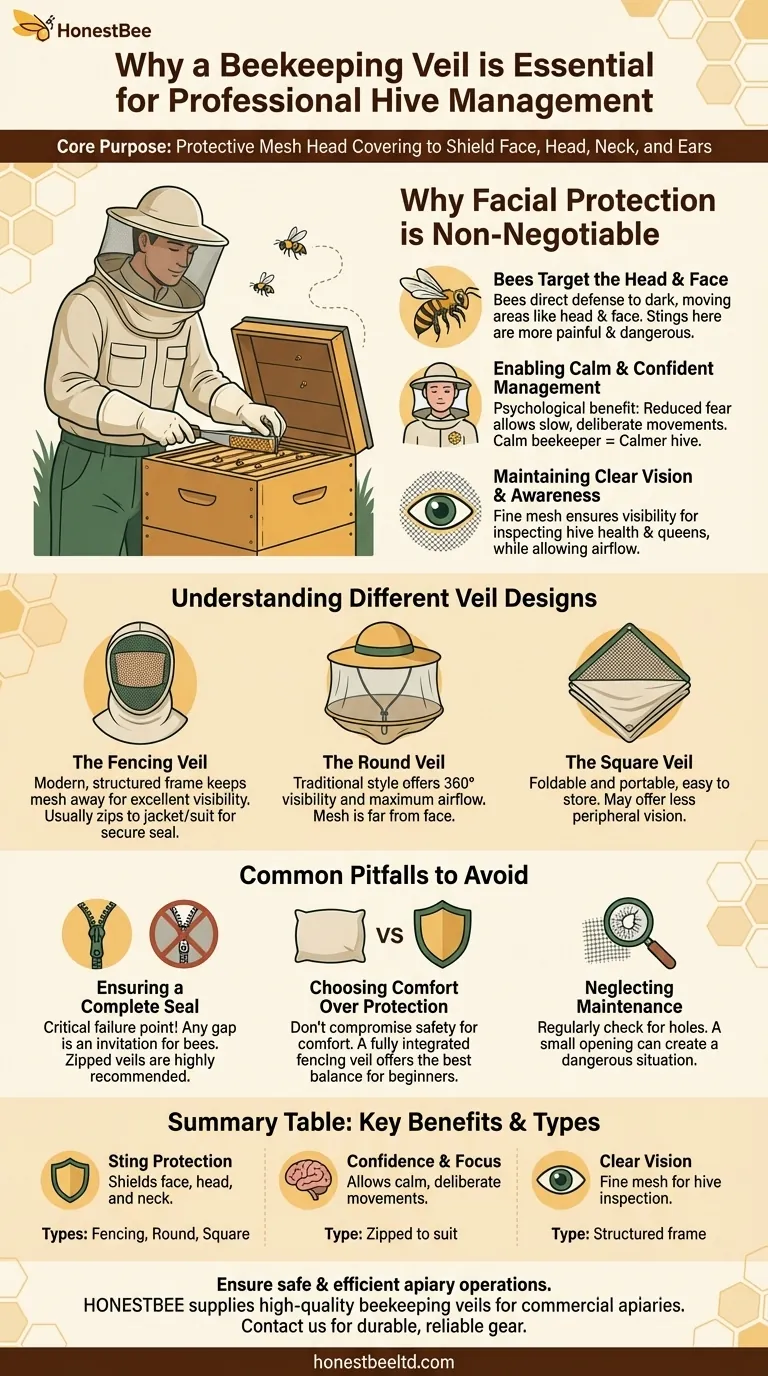
Related Products
- Heavy Duty Cowboy Beekeeper Hat with Visibility Veil Outdoor Professional Beekeeping Protective Gear
- Beekeeper Cowboy Hat and Veil for Beekeeping
- Square Folding Bee Hat Veil with String for Beekeeping
- Professional Beekeeping Suit for Kids and Girls Childrens Bee Keeper Suit
- Professional Galvanized Hive Strap with Secure Locking Buckle for Beekeeping
People Also Ask
- What is the purpose of a hat and veil in beekeeping? Essential Protection for Head & Face
- Why are a hat and veil considered the most important parts of beekeeping protective gear? Essential Protection for Your Face and Confidence
- How should the beekeeping hat veil be cleaned? The Only Safe Method to Preserve Protection
- How does the design of the beekeeping hat ensure comfort during extended use? Maximize Comfort for Long Apiary Hours
- How can beekeeping supplies and accessories enhance the hobby? Essential Tools for Safe & Rewarding Beekeeping





